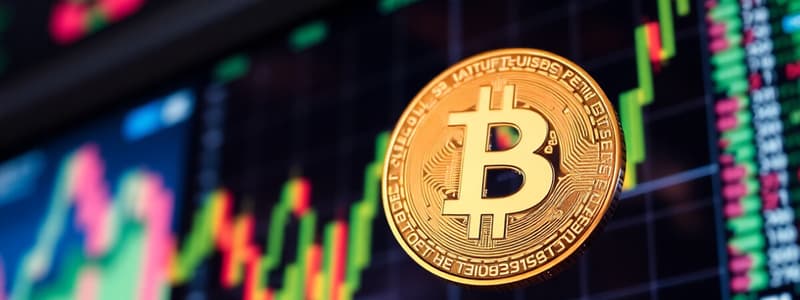Podcast
Questions and Answers
Which type of long-term memory is consciously recalled and can be verbally expressed?
Which type of long-term memory is consciously recalled and can be verbally expressed?
- Explicit memory (correct)
- Implicit memory
- Priming
- Procedural memory
Which of the following best describes semantic memory?
Which of the following best describes semantic memory?
- Influence of prior exposure on later stimulus responses
- Memory of personally experienced events
- Memory of general knowledge (correct)
- Memory for the performance of skills
Episodic memory is primarily concerned with:
Episodic memory is primarily concerned with:
- Motor skills and habits
- Personally experienced events (correct)
- Unconscious influences on behavior
- General knowledge and facts
Which characteristic is most indicative of implicit memory?
Which characteristic is most indicative of implicit memory?
Procedural memory is particularly essential for:
Procedural memory is particularly essential for:
Priming primarily affects responses by:
Priming primarily affects responses by:
Which exemplifies a classically conditioned association?
Which exemplifies a classically conditioned association?
What is the primary limitation of short-term memory in the Atkinson & Shiffrin model?
What is the primary limitation of short-term memory in the Atkinson & Shiffrin model?
According to the Atkinson & Shiffrin model, what is the estimated capacity of short-term memory?
According to the Atkinson & Shiffrin model, what is the estimated capacity of short-term memory?
What is the primary characteristic of long-term memory according to the Atkinson & Shiffrin model?
What is the primary characteristic of long-term memory according to the Atkinson & Shiffrin model?
According to the Atkinson & Shiffrin model, what is the capacity of long-term memory?
According to the Atkinson & Shiffrin model, what is the capacity of long-term memory?
In the Atkinson & Shiffrin model, what is the primary function of sensory memory?
In the Atkinson & Shiffrin model, what is the primary function of sensory memory?
What is the duration of sensory memory?
What is the duration of sensory memory?
What type of sensory memory is specific to visual information?
What type of sensory memory is specific to visual information?
Which type of sensory memory is associated with auditory information?
Which type of sensory memory is associated with auditory information?
What did Sperling's (1960) experiment primarily demonstrate about sensory memory?
What did Sperling's (1960) experiment primarily demonstrate about sensory memory?
In Sperling’s experiment, what was the main challenge participants faced when asked to recall all the letters presented?
In Sperling’s experiment, what was the main challenge participants faced when asked to recall all the letters presented?
Which long-term memory system uses prior exposure to influence behavior?
Which long-term memory system uses prior exposure to influence behavior?
Which best illustrates the function of episodic memory?
Which best illustrates the function of episodic memory?
Which of the following is the most accurate representation of echoic memory?
Which of the following is the most accurate representation of echoic memory?
Which cognitive process is most closely associated with priming?
Which cognitive process is most closely associated with priming?
How do episodic and semantic memory systems work together to facilitate autobiographical memory?
How do episodic and semantic memory systems work together to facilitate autobiographical memory?
How does working memory interact with both sensory and long-term memory to enable complex cognitive tasks?
How does working memory interact with both sensory and long-term memory to enable complex cognitive tasks?
What distinguishes classical conditioning from priming mechanisms in terms of cognitive processing?
What distinguishes classical conditioning from priming mechanisms in terms of cognitive processing?
Which statement describes the relationship between implicit and explicit memory?
Which statement describes the relationship between implicit and explicit memory?
How would the principles of priming likely influence consumer behavior related to brand recognition?
How would the principles of priming likely influence consumer behavior related to brand recognition?
How does the three-stage model of memory processing account for the experience of suddenly remembering a forgotten detail?
How does the three-stage model of memory processing account for the experience of suddenly remembering a forgotten detail?
How does maintenance rehearsal in short-term memory directly affect long-term memory encoding?
How does maintenance rehearsal in short-term memory directly affect long-term memory encoding?
How does the duration of iconic memory influence our ability to perceive motion continuously?
How does the duration of iconic memory influence our ability to perceive motion continuously?
How do everyday examples of episodic memory interact with priming influences on decision-making?
How do everyday examples of episodic memory interact with priming influences on decision-making?
How might variations in working memory capacity influence the strength of classically conditioned emotional responses?
How might variations in working memory capacity influence the strength of classically conditioned emotional responses?
In what ways does our capacity for semantic knowledge influence the precision and reliability of eyewitness testimony?
In what ways does our capacity for semantic knowledge influence the precision and reliability of eyewitness testimony?
How does the ability to consciously control encoding into long-term memory influence vulnerability to false memories?
How does the ability to consciously control encoding into long-term memory influence vulnerability to false memories?
How might procedural memory affect responses in high-pressure situations?
How might procedural memory affect responses in high-pressure situations?
How do the separate contributions of explicit and implicit memory systems enhance our comprehension of social dynamics?
How do the separate contributions of explicit and implicit memory systems enhance our comprehension of social dynamics?
How does the interplay between episodic and semantic memory facilitate knowledge?
How does the interplay between episodic and semantic memory facilitate knowledge?
According to the Atkinson & Shiffrin model, which of the following scenarios best illustrates the flow of information through the three stages of memory?
According to the Atkinson & Shiffrin model, which of the following scenarios best illustrates the flow of information through the three stages of memory?
How does the interaction between priming and procedural memory influence skill acquisition?
How does the interaction between priming and procedural memory influence skill acquisition?
How might the principles of classical conditioning explain the development of taste aversions, and what role does memory play in maintaining these aversions?
How might the principles of classical conditioning explain the development of taste aversions, and what role does memory play in maintaining these aversions?
In what ways do both iconic and echoic memory contribute to overall sensory processing capacity?
In what ways do both iconic and echoic memory contribute to overall sensory processing capacity?
How does explicit memory contribute to the formation and recollection of declarative knowledge?
How does explicit memory contribute to the formation and recollection of declarative knowledge?
How might individual differences in working memory capacity influence the effectiveness of strategies designed to enhance long-term memory encoding?
How might individual differences in working memory capacity influence the effectiveness of strategies designed to enhance long-term memory encoding?
Flashcards
Explicit memory
Explicit memory
Conscious recollection of material from long-term memory.
Semantic memory
Semantic memory
Memory of general knowledge.
Episodic memory
Episodic memory
Memory of personally experienced events.
Implicit memory
Implicit memory
Signup and view all the flashcards
Procedural memory
Procedural memory
Signup and view all the flashcards
Priming
Priming
Signup and view all the flashcards
Short-term memory
Short-term memory
Signup and view all the flashcards
Long-term memory
Long-term memory
Signup and view all the flashcards
Sensory memory
Sensory memory
Signup and view all the flashcards
Iconic memory
Iconic memory
Signup and view all the flashcards
Echoic memory
Echoic memory
Signup and view all the flashcards
Classically conditioned associations
Classically conditioned associations
Signup and view all the flashcards
Study Notes
- Algorithmic trading, also known as "Algo Trading" or "Black-Box Trading," uses computer programs and algorithms to execute trades based on factors like timing, price, and quantity.
High-Frequency Trading (HFT)
- A type of algorithmic trading with high speeds, turnover rates, and order-to-trade ratios, used by proprietary firms.
Trend Following Strategies
- Simple strategies that capitalize on trends, such as using a 50-day Moving Average (MA) for buy/sell signals.
Arbitrage
- Exploiting small price differences of the same asset on different exchanges, which algorithms can identify and capitalize on efficiently.
Mathematical Model-Based Strategies
- Involve complex mathematical models and programming skills, like Pairs Trading, which identifies correlated stocks to short the overperforming one and long the underperforming one when the correlation breaks down.
Index Fund Rebalancing
- Automating the periodic rebalancing of index fund portfolios and creating opportunities for algorithmic traders to profit from temporary price movements.
Sentiment Analysis
- Gauging market sentiment from news articles and social media posts to make trading decisions: positive sentiment signals to buy and negative sentiment signals to sell.
Reduced Emotional Influence in Algorithmic Trading
- Algorithms make decisions based on predefined rules, eliminating emotional biases.
Increased Speed and Efficiency in Algorithmic Trading
- Algorithms execute trades faster than humans and can monitor multiple markets simultaneously.
Backtesting of Algorithmic Trading
- Algorithms can be backtested using historical data to optimize strategies before deploying them in live markets.
Technical Issues in Algorithmic Trading
- Algorithm failures can lead to unexpected losses, requiring continuous monitoring and maintenance.
Over-Optimization of Algorithmic Trading
- Over-optimized algorithms may perform well on historical data but fail in live markets (curve fitting).
Market Impact of Algorithmic Trading
- Large algorithmic trades can impact market prices, potentially leading to adverse results.
Studying That Suits You
Use AI to generate personalized quizzes and flashcards to suit your learning preferences.



